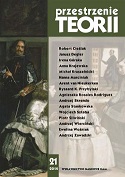O marginaliach (i nie tylko) Tadeusza Różewicza
On Różewicz’s margin notes (and not only)
Author(s): Janusz DeglerSubject(s): Fine Arts / Performing Arts, Photography, Studies of Literature, Polish Literature, Theory of Literature
Published by: Uniwersytet Adama Mickiewicza
Keywords: Polish literature; Tadeusz Różewicz; photography; marginalia;
Summary/Abstract: Tadeusz Różewicz moved from Gliwice to Wrocław in 1968. He lived near South Park for many years and he regularly met there with the author of this article. They talked about many different things and current events, and especially about Stanisław Ignacy Witkiewicz, i.e. more specifically about his service in the tsarist army, the battle that took place near the Stokhid in June 1916 in which he was severely wounded as well as about the causes of his suicide in September 1939. In 2003 Różewicz moved to a house on Promień Street, which is located in a remote area of the city. When he was moving to the new place he came across Witkacy’s 1919 treatise titled Nowe formy w malarstwie i wynikające stad nieporozumienia [New Forms in Painting and the Misunderstandings Arising Therefrom], which he had bought in October 1945 at a street stall in Warsaw. After a careful reading of the treatise (as evidenced by numerous underlines in the text), he decided to enroll in the Academy of Fine Arts in Cracow. The quotes that are presented in the article show that Różewicz paid particular attention to Witkacy’s main philosophical concepts (“metaphysical anxiety”) and statements about the end of metaphysics in the 20th century. Many notes and annotations in the margins, some of which are cited in the present article, are evidence of Witkacy’s critical reading of Leon Chwistek’s “Wielość rzeczywistości w sztuce” i inne szkice literackie [The Multiplicity of Realities in Art and Other Literary Sketches]. In 1975 Anna Micińska published, based on a manuscript that had been discovered, the sociocultural study Niemyte dusze [Unwashed Souls] which Witkacy wrote in 1936 but which he did not manage to publish. Różewicz regarded this study as one of Witkacy’s most interesting works because it showed a whole different side of the artist – a citizen who was concerned about the condition of Polish society and the Polish state.
Journal: Przestrzenie Teorii
- Issue Year: 2014
- Issue No: 21
- Page Range: 11-22
- Page Count: 12
- Language: Polish

